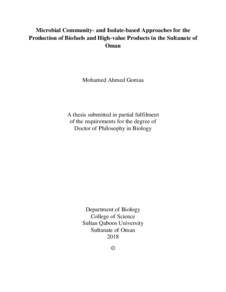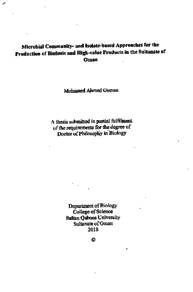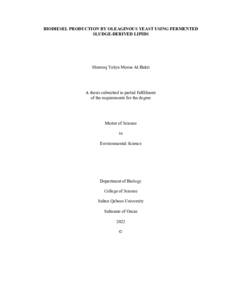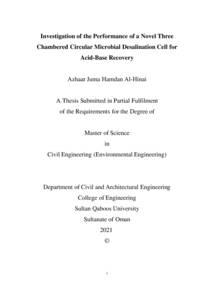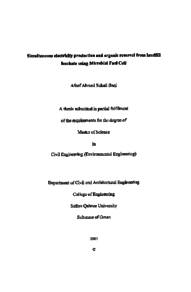Document
Microbial community-and lsolate-based approaches for the production of biofuels and high-value products in the Sultanate of Oman
Publisher
Sultan Qaboos University
Gregorian
2018
Language
English
English abstract
The modern world has come to the realization that our industrial productivity has been having detrimental effects on the environment, like the release of high amounts of greenhouse gases from factories making high-value products and transportation vehicles. As a consequence, many of the world's influential entities have been striving for the preservation of our environment while maintaining technological and industrial advancement. A major contributor to the large carbon footprint of modern civilization is the use of fossil fuels for transportation and in large industrial factories for the production of high-value products. An attractive alternative for the use of fossil fuels, which cause a lot of carbon and nitrogen emissions, is the more environmentally benign biofuels. Apart from biofuels, production of high-value products has been gaining momentum with the advancements in genetic engineering. However, production of biofuels and high-value products has not been investigated from the various unexplored ecosystems and renewable sources available in the Sultanate of Oman. Therefore, this doctoral study investigated the potential of available and cheap resources (like organic wastes, lignocellulosic leaves and microbial mats), which have been deemed an environmental burden, for the production of different types of biofuels (specifically bioethanol, biodiesel and biomethane). Furthermore, genetic engineering techniques have been employed for the generation of a phototrophic mutant capable of producing astaxanthin, which is considered a high-value compound in today's market. The approaches taken in this doctoral thesis are based on the use of either communities or isolates for the production of biofuel or high-value compounds. The results of this doctoral thesis would form a strong basis for biofuel and high-value compound production in the Sultanate of Oman. Below is a summary of the different studies performed in this doctoral thesis.
Study One: Potential of fecal waste for the production of bioethanol, biodiesel and biomethane.
• Fecal waste was compared from different sources for bioethanol, biodiesel and biomethane production.
• The microbial community composition was compared before and after anaerobic digestion.
• Production of bioethanol was achieved from all samples, with chicken fecal waste yielding as high as 530 ± 85 mg/g substrate.
• Sludge samples exhibited the highest extractable portion of lipids (20.9 ± 0.08 wt%) and conversion to fatty acid methyl esters (11.94 wt%).
• All fecal waste produced biomethane, with the highest yield of 433.4 ± 77.1 ml CH4/g VS from cow fecal waste.
vi
Study Two: Effect of organic solvents and acidic catalysts on biodiesel yields from primary sewage sludge and characterization of fuel properties.
• Primary sewage sludge was used for the production of biodiesel and compared yields at different temperatures (40, 50 and 60°C), organic solvents (chloroform, toluene and hexane), acid catalysts (HCl and H2SO4) and catalyst concentrations (3, 5 and 7%).
• Fuel properties of the extracted biodiesel under the optimized conditions were investigated.
• A maximum of 18 wt% biodiesel was obtained using chloroform with 3% H2SO4 at 40°C.
• The produced biodiesel had fuel properties that were within the limits of accepted international standards.
Study Three: Desert stream phototrophic mats: a promising source for biofuel production.
• 11 different microbial mats were screened for their carbohydrate and lipid contents and their ability to produce methane.
• A maximum bioethanol yield of 254 ± 33 mg/g substrate was obtained by enzymatic saccharification of a Spirogyra-dominant mat followed by fermentation using the native Clostridium strain AK-1.
• A lipid content of 9–18 wt% was measured from the microbial mats.
• Anaerobic digestion of one selected mat for biomethane production yielded a maximum of 95 mL CH4/g VS after 49 days.
• MiSeq analysis revealed that the microbial community of this mat was 99.5% dominated by archaea after anaerobic digestion.
Study Four: Comparing bioethanol production using buttonwood (Conocarpus erectus) and date palm (Phoenix dactylifera) leaves as raw material.
• This work focuses on comparing bioethanol production from buttonwood and date palm leaves.
• Cellulase activities were compared at different temperature, pH and metal ion supplementation conditions.
• The bioethanol yields were compared between a Clostridium aciditolerans sp. and Saccharomyces cerevisiae as fermentative organisms.
vii
• Cellulase activities of 372 and 192 U/g substrate were obtained using buttonwood and date palm leaves, respectively, under optimal conditions (at 50°C, pH 7 with Na and K ion supplementation).
• C. aciditolerans yielded a maximum of 670 and 270 mg bioethanol/g substrate using buttonwood and date palm leaves, respectively, while S. cerevisiae yielded 710 and 300 mg/g substrate.
• C. aciditolerans required 96 hours to reach maximum yield, while S. cerevisiae needed just 10 hours.
Study Five: Utilization of a nickel-inducible expression vector for the generation of an astaxanthin producing Synechocystis sp. PCC6803 mutant.
• Generating an astaxanthin producing mutant of Synechocystis was attempted by incorporation of the crtW gene from Haematococcus pluvialis that encodes for a symmetrical diketolase (crtW) enzyme into the Synechocystis genome.
• A single mutant was obtained from this study that was positively identified for producing a functional crtW enzyme.
• Produced astaxanthin from the obtained mutant was measured to be 207 mg/g dry cell weight using ultra performance liquid chromatography.
Description
Thesis
Member of
Resource URL
Arabic abstract
لقد أدرك العالم الحديث أن إنتاجيتنا الصناعية كانت لها آثار ضارة على البيئة ، مثل إطلاق كميات كبيرة من غازات الدفيئة من المصانع التي تصنع منتجات ذات قيمة عالية ومركبات نقل. ونتيجة لذلك، فإن العديد من الكيانات المؤثرة في العالم تسعى جاهدة للحفاظ على بيئتنا مع الحفاظ على التقدم التكنولوجي والصناعي. أحد المساهمين الرئيسيين في البصمة الكربونية الكبيرة للحضارة الحديثة هو استخدام الوقود الأحفوري للنقل وفي المصانع الصناعية الكبيرة لإنتاج منتجات عالية القيمة. إن البديل الجذاب لاستخدام الوقود الأحفوري، الذي يسبب الكثير من انبعاثات الكربون والنيتروجين، هو الوقود الحيوي الأكثر حميمية بيئيا.ً بصرف النظر عن الوقود الحيوي، يكتسب إنتاج المنتجات عالية القيمة زخما مع التقدم في الهندسة الوراثية. ومع ذلك، لم يتم التحقيق في إنتاج الوقود الحيوي والمنتجات ذات القيمة العالية. ومع ذلك، لم يتم بحث إنتاج الوقود الحيوي والمنتجات عالية القيمة من مختلف النظم الإيكولوجية غير المستكشفة والمصادر المتجددة المتاحة في سلطنة عمان. ولذلك، فإن دراسة الدكتوراه هذه بحثت في إمكانات الموارد المتاحة والرخيصة )مثل النفايات العضوية والأوراق الحلزونية والحصائر الميكروبية(، والتي اعتبرت عبئا بيئيا، لإنتاج أنواع مختلفة من الوقود الحيوي )على وجه التحديد الإيثانول الحيوي، الديزل الحيوي والبيوميتان(. وعلاوة على ذلك، تم استخدام تقنيات الهندسة الوراثية لتوليد متحولة ضوئية قادرة على إنتاج أستازانتين، والذي يعتبر مركبًا عالي القيمة في السوق اليوم. تستند المناهج المتبعة في أطروحة الدكتوراه هذه على استخدام إما المجتمعات أو العزلات لإنتاج الوقود الحيوي أو المركبات عالية القيمة. وستشكل نتائج أطروحة الدكتوراه هذه أساسًا قويًا لإنتاج الوقود الحيوي والمركب عالي القيمة في سلطنة عمان.
Category
Theses and Dissertations

